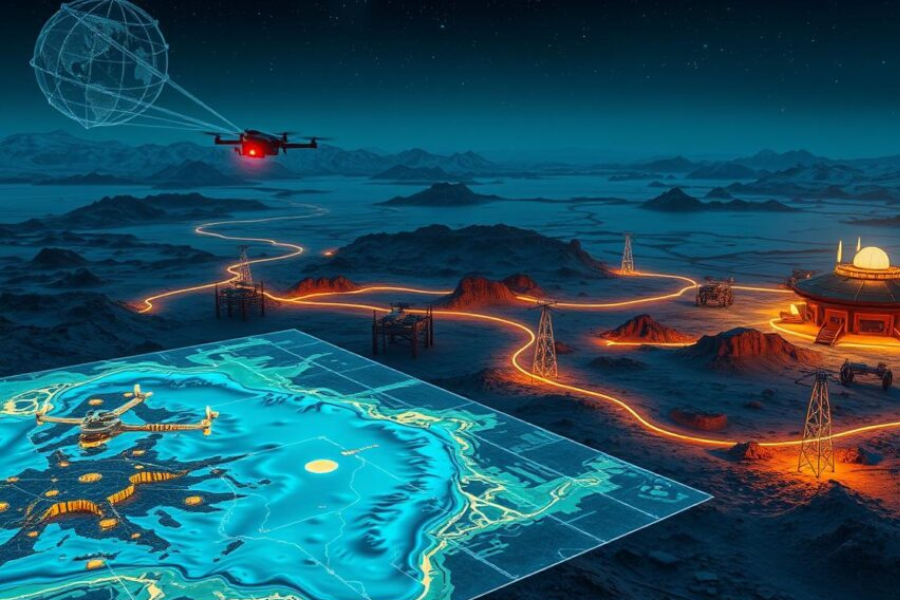
Introduction: The New Era of Geophysics
The geophysics field is currently undergoing a significant transformation fueled by rapid advancements in digital technologies. Tools such as advanced data collection methods, machine learning, and visualization software are redefining how researchers study Earth’s subsurface, offering unprecedented insights into geophysical phenomena. This integration of technology isn’t just a fleeting trend but a new frontier shaping the way the geophysics industry operates, conducts research, and solves global challenges like resource exploration and environmental monitoring.
How Digital Technologies Are Transforming Geophysics
The introduction of digital technology has completely revolutionized traditional geophysics. Remote sensing tools, including drones, have made it possible to collect geological data from remote or dangerous regions more safely and efficiently. The data collected is then processed with machine learning algorithms, which allow researchers to detect patterns that humans would take much longer to identify. These algorithms also provide the added benefit of speeding up the decision-making process, making it easier to predict geological events such as earthquakes or mineral deposits.
Cloud computing plays a crucial role as well, enabling global collaboration by allowing researchers to work on the same datasets in real-time, no matter where they are located. These advancements have streamlined complex research efforts and increased accessibility to geophysical data.
Another breakthrough is the use of Virtual Reality (VR) and Augmented Reality (AR). These immersive technologies allow geophysicists to visualize subsurface structures in 3D, offering an intuitive and interactive way to understand complex data. Through these virtual models, stakeholders and scientists can explore intricate geological formations as if they were on-site.
Advantages of Digital Transformation in Geophysics
Digital transformation in geophysics offers numerous advantages that improve the efficiency, accuracy, and scope of research. First and foremost, data analytics are significantly enhanced. Modern geophysical tools can deliver much more accurate imaging of subsurface structures, making it easier to map mineral resources or monitor environmental changes like deforestation or pollution. This detailed understanding reduces the environmental and financial risks associated with exploratory projects like mining or drilling.
Another key advantage is automation, which allows tasks like seismic data analysis to be processed in real-time. Automated systems not only increase productivity but also reduce the potential for human error. This is particularly useful in dynamic environments where timely decision-making is essential, such as during natural disaster monitoring.
However, the challenges of adopting these new technologies must also be addressed. For example, the cost of implementing high-tech solutions can be prohibitive for smaller organizations. Furthermore, the rapid pace of technological change requires continuous upskilling of personnel to ensure they can work with the latest tools effectively.
Innovative Tools in the Digital Geophysics Toolbox
In the ever-evolving landscape of geophysics, several cutting-edge tools and techniques are pushing the field forward. One of the most transformative technologies is machine learning, which helps interpret large datasets much faster than traditional methods. This capability is particularly valuable when analyzing seismic or magnetic data, where hidden patterns could indicate oil reserves or geothermal activity.
Drone technology has also become a game-changer in geophysics. Equipped with sophisticated sensors, drones can conduct aerial surveys of hard-to-reach or hazardous locations, covering large geographical areas in record time. This reduces both human risk and project costs while delivering high-quality data.
Cloud computing is another essential tool, facilitating collaboration between researchers from different parts of the world. By enabling real-time data sharing and processing, cloud platforms have transformed how global teams work together on complex geophysical projects.
Augmented Reality (AR) is also making waves in the field, offering geophysicists immersive, interactive experiences when visualizing geological formations. AR tools allow researchers to manipulate 3D models in real-time, offering more dynamic insights into subsurface phenomena.
Case Studies: Real-World Impact of Digital Transformation
Several industry leaders have already seen significant results by integrating digital technologies into their operations. A leading oil and gas company, for example, employed machine learning algorithms to analyze seismic data, leading to more accurate predictions for potential drilling sites. This not only reduced exploration costs but also minimized environmental risks by optimizing drilling locations.
In another example, a mining firm used drone technology for aerial surveys. These drones provided high-resolution data over large mining areas, improving resource extraction efficiency while minimizing environmental impact.
In geothermal energy, advanced modeling software has allowed engineers to simulate different scenarios for geothermal wells, optimizing energy output while ensuring the sustainable use of resources.
These examples demonstrate that digital transformation is not just a theoretical concept but an applied practice that delivers tangible benefits in terms of efficiency, cost reduction, and environmental responsibility.
Challenges in Digital Geophysics
Despite the promising advancements, there are significant challenges that come with digital transformation in geophysics. One of the most notable barriers is the high cost of implementing new technologies, which can be prohibitive, especially for smaller firms.
Data security is another critical concern. With increasing amounts of sensitive data being stored and shared online, the risk of cyber-attacks becomes a pressing issue. Geophysics companies must invest in robust cybersecurity measures to protect their data and ensure that it is only accessible to authorized personnel.
Moreover, integrating new digital tools into traditional workflows can be tricky. Resistance to change and the steep learning curve of new technologies often hinder their adoption, meaning that training programs and change management strategies must be put in place to ensure a smooth transition.
The Future of Digital Transformation in Geophysics
Looking ahead, the potential for growth in the field of digital transformation geophysics is enormous. Emerging technologies like artificial intelligence (AI) and machine learning will continue to play pivotal roles in how geophysical data is analyzed and interpreted. These technologies are particularly promising for resource exploration, where they can identify and analyze vast amounts of data, reducing both the time and cost of exploration.
Improved sensor technologies will also drive innovation. Sensors are becoming more sophisticated, capturing real-time data with increasing accuracy. This will allow for more precise monitoring of geological changes, such as earthquake precursors, offering the potential to save lives through early warning systems.
Increased collaboration between tech companies and geophysicists will also play a significant role in the field’s future development. By working together, these industries can develop customized solutions to address specific challenges like environmental monitoring or resource management.
In conclusion
, digital transformation in geophysics is not just reshaping the field; it is expanding its potential. As technology continues to evolve, the possibilities for deeper insights into Earth’s https://buzztelecast.com/ structure and processes are limitless. Researchers and professionals who embrace these changes are better equipped to meet the challenges and opportunities of the future, making geophysics a more dynamic, innovative, and essential field in addressing the global issues of today and tomorro







